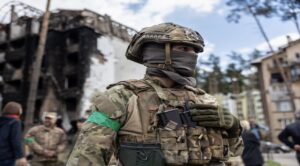Ukraine’s summer counteroffensive has failed, we’re told, with headlines like “U.S. Intel Insiders Admit To Russia’s ‘Victory,’” even if that one is from the reliably pro-Kremlin Hindustan Times quoting the reliably unreliable Seymour Hersh.
Even more sobering takes highlight Russia’s “devilishly brilliant series of defensive trenches,” which have resulted in a “failure — so far” of the operation.
The naysayers are given credence by a look at the map of the frontlines, which have barely moved since the counteroffensive started in June. If we take a step back, the situation looks worse for Kyiv than it does for Moscow. It’s not that everything is perfect.
Let’s take a look at some of the details that lie beneath the headlines. They are spectacular.
As an aside, I’ll repeat it again: It is not our concern whether Russia seizes all of Ukraine, a portion, or none at all. This isn’t our battle. Putin has broken the peace in Europe, and we must punish him with every tank and shell that we can send Ukraine’s way. In this century, people seem to forget that Europe’s wars can spread globally (at least 4 times plus 45 years Cold War).

Kyiv is not managing expectations well. Many observers thought that the Ukraine Army would be able to repeat its rapid advances in 2022 which forced Russian forces from Kharkiv, Kherson, and other cities.
In April, I said that Kyiv’s chances of achieving similar results by 2023 are nil.
The chances that Ukraine will be able to remove the Russians from their position in a rapid counteroffensive is essentially zero.
AFU officer expressed his “cautionary thought” regarding the counteroffensive in the Ukraine War last month, warning that it was time to “temper expectations” of clearing Russian forces out of the country completely this year – or perhaps ever.
Someone in Ukraine has finally tempered those unrealistic expectations. The Ukraine Army has finally reached the third line of Russia’s “devilishly intelligent” defensive lines. UA Gen. Oleksandr Ternavsky told CNN that the “minimum goal is Tokmak (in the direction of the important city of Melitipol)”.

Tokmak, in June, was approximately 20 miles behind the Russian line. It’s now about half the distance.
It is true that the progress is slow, but so was it at first in Kherson and Kharkiv. The “rapid” counteroffensives in Kharkiv and Kherson were preceded by weeks under constant pressure, as well as the systematic destruction of Russian logistics.
Kyiv also has been attacking Russia’s air defense systems, with spectacular results. Ukraine used a combination of Anglo-French Storm Shadow Cruise Missiles and drones earlier this month to destroy both a Russian Kilo-class attack sub (one out of six in the Black Sea), and an amphibious assault vessel. Both vessels were docked at a ship repair yard, which will be out of service for weeks or even months to remove the wreckage of these two warships.
The airstrike on the Black Sea Fleet’s headquarters in Russia, which took place Friday, was perhaps the most spectacular outcome of Russia’s weakened air defenses.
Slowed down and zoomed-in footage of the Ukrainian Storm Shadow/SCALP ALCM slamming into (and through) the roof of the Russian Black Sea Fleet headquarters. pic.twitter.com/c8mas1OzAg
— OSINTtechnical (@Osinttechnical) September 22, 2023
Admiral Viktor Sokolov, commander of the Black Sea Fleet, and 33 other officers were confirmed dead. A further 105 people are thought to have been injured. This was a major blow that required weeks of planning and split-second timing, made possible by the latest intelligence.
Both of these airstrikes were on Sevastopol, the fortress naval at the center of Russia’s Black Sea jewel. It is generally considered one of the most well-defended cities on the planet.
I was also interested in three other stories.
The first is: “Using innovative attack, Ukraine has eroded Russia’s formidable naval edge, and it’s starting to reopen the port.” These ports are Ukraine’s main lifeline to the rest of the world, and the Russian Navy’s inability to keep them closed says volumes. It’s not bad for a nation like Ukraine, which doesn’t have a navy.

The second example is: “Russia temporarily banned the import of gasoline and diesel from all countries other than a grouping of four ex-Soviet states, in order to stabilize its domestic fuel markets as supplies of fuel to the military surge.” This rate of fuel consumption while on defense — which consumes less fuel than offensive operations — indicates something’s wrong. It’s either that Russian oil production is down, Ukraine is affecting Russian logistics more than people realize, or Russia has been stockpiling fuel for an upcoming offensive. The third option is least likely because Russia did not have to stop fuel exports in the past, when it was advancing along four different axes, and not only defending one.
Here is the third report, Russia’s rare admission about the harsh reality of the Ukraine war. Andrey Kartapolov, the chair of the Russian State Duma Defense Committee, said in a new admission that the situation on the front was grim. He also stated that personnel could not be rotated away from the operational zone while they were serving.
Even with its huge manpower advantage, Moscow can’t afford to rotate troops out for rest, recuperation, and resupply. Even in the gawdawful trench fighting of World War I, troops were regularly rotated out and allowed a break. Russian soldiers historically have a near-suicidal ability to hang on, no matter how abused they are — by their own government. But there’s still only so much even a Russian mobik can take.
It’s anyone’s guess what will happen next, but it is far too soon to call anything a fail.




